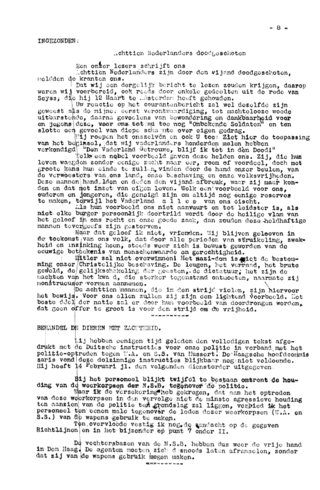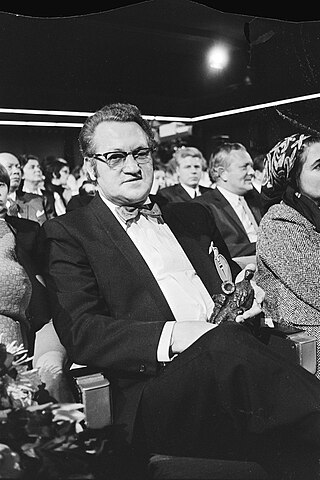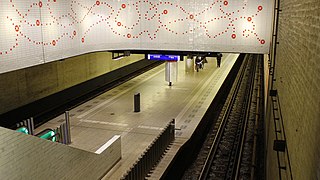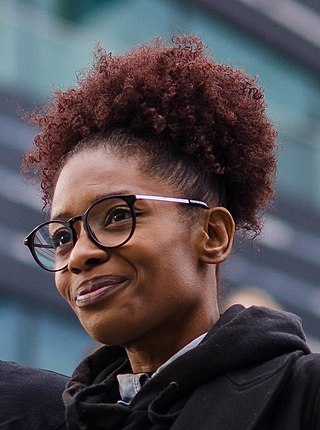
Haarlemmermeer is a municipality in the west of the Netherlands, in the province of North Holland. Haarlemmermeer is a polder, consisting of land reclaimed from water. The name Haarlemmermeer means 'Haarlem's lake', referring to the body of water from which the region was reclaimed in the 19th century.

Het Parool is an Amsterdam-based daily newspaper. It was first published on 10 February 1941 as a resistance paper during the German occupation of the Netherlands (1940–1945). In English, its name means The Password or The Motto.

Johnny Jordaan was the pseudonym for Johannes Hendricus van Musscher, a Dutch singer of popular music, in particular the genre known as levenslied, a Dutch variety of the French chanson. He was well known for his songs about the city of Amsterdam, especially the Jordaan district, which he sang in a typical "hiccuping Mokum vibrato", "Mokum" being the Hebrew-derived nickname for the Amsterdam inner city area. In the 1950s, Johnny Jordaan rose almost instantly to the level of national celebrity and became the "uncrowned king of the Jordaanlied", and his hit song "Geef mij maar Amsterdam" is one of the songs Amsterdammers identify with most.

The National Maritime Museum is a maritime museum in Amsterdam in the Netherlands.

DPG Media Group is a Belgian media company also active in the Netherlands and Denmark. It is owned by the Van Thillo family and employs some 6,000 people.

Amsterdam, capital of the Netherlands, has more than 100 kilometers (62 mi) of grachten (canals), about 90 islands and 1,500 bridges. The three main canals, dug in the 17th century during the Dutch Golden Age, form concentric belts around the city, known as the Grachtengordel. Alongside the main canals are 1550 monumental buildings. The 17th-century canal ring area, including the Prinsengracht, Keizersgracht, Herengracht and Jordaan, were listed as UNESCO World Heritage Site in 2010, contributing to Amsterdam's fame as the "Venice of the North".

Thom de Klerk . Dutch bassoonist, double reed maker, music teacher, conductor and music director. Thom de Klerk was the first solo bassoonist of the Royal Concertgebouw Orchestra from 1935 until 1966. He was successful with the directors Willem Mengelberg, Eduard van Beinum and Bernard Haitink. Guest directors like Eugen Jochum, Arturo Toscanini and Pierre Monteux made special requests for his presence in the orchestra.

Nieuwmarkt is an underground metro station in the city centre of Amsterdam, Netherlands. Served by metro lines 51, 53 and 54 of the Amsterdam Metro, the station was constructed by sinking caissons with a length of 40 metres (130 ft). This construction method resulted in the demolition of parts of the Nieuwmarkt neighbourhood and was met with protests.

Waterlooplein is an underground metro station in the city centre of Amsterdam, Netherlands. Served by metro lines 51, 53 and 54 of the Amsterdam Metro, the station was constructed by sinking caissons with a length of 40 metres (130 ft), with the first one being lowered in 1972. There were "open tube" days in 1975 showcasing the station, which was the first time the public got access to the underground tunnels of the metro system.

Weesperplein is an underground metro station in the city centre of Amsterdam, Netherlands. Served by metro lines 51, 53 and 54 of the Amsterdam Metro, the station was constructed using caissons with a length and width of 40 metres (130 ft). The station has two floors: an upper station hall with stores and the lower floor with the tracks. The first metro train rolled into it in January 1977. Extensive tests were carried out in September before the station opened on 16 October.

Wibautstraat is an underground metro station in the city centre of Amsterdam, Netherlands. Served by metro lines 51, 53 and 54 of the Amsterdam Metro, the station was constructed with the cut-and-cover method. It was opened on 16 October 1977. The station consists of two station halls with two entrances each. The 155-metre-long (509 ft) island platform is between the two halls. The station was renovated in 2010 and 2018.

Pieter Mortier, or Pierre Mortier as the publisher of books in French, was the name of three successive generations of booksellers and publishers in the Dutch Republic.

Silvana Hildegard "Sylvana" Simons is a Surinamese-born Dutch politician and former television presenter. She has been a member of the House of Representatives since 2021 on behalf of BIJ1, an egalitarian anti-racist party founded by Simons in 2016.

BIJ1, formerly known as Article 1, is a political party in the Netherlands. It was founded in Amsterdam in 2016 by Sylvana Simons, a television personality who was formerly connected to another party, Denk. BIJ1 aligns itself as an anti-capitalist, progressive left-wing party, advocating economic justice and opposing racism and discrimination in the Netherlands.
Broekman is a Dutch toponymic surname equivalent to the Dutch surname Van den Broek. In Dutch, a broek is low-lying land regularly flooded by rivers or brooks. People with this name include:

We Are Here is a collective of migrants based in Amsterdam, the Netherlands, which campaigns for human rights for its members and all undocumented migrants. The asylum seekers have in many cases had their applications to remain in the Netherlands denied but they either cannot go back or refuse to return to their country of origin. They ask for access to social services such as medical care and housing. The group formed in 2012 and by 2015 contained over 200 migrants from around 15 countries.

The Tabakspanden are a group of buildings standing on the Spuistraat in central Amsterdam, adjacent to the Keizerrijk and Wijdesteeg alleyways. Named after a previous owner called Hendrik Tabak, they were mostly squatted from 1983 onwards, although Peter Klashorst also rented an apartment and gallery space. Two of the buildings are registered as rijksmonumenten.

The Sugarfactory was a music venue and night club in Amsterdam, Netherlands. It was located on the Lijnbaansgracht, near the Leidseplein in the centre of Amsterdam.

Night Mayor is a municipal title used for someone who represents and helps develop a city's nightlife. The earliest known use of the title was in Rotterdam, Netherlands.

Moshé Zwarts was a Dutch architect, founder of the architectural office ZJA and a former senior professor of Architectural Technology at the Technical University of Delft and the Technical University of Eindhoven. His portfolio encompasses many infrastructural projects including football stadiums.



















